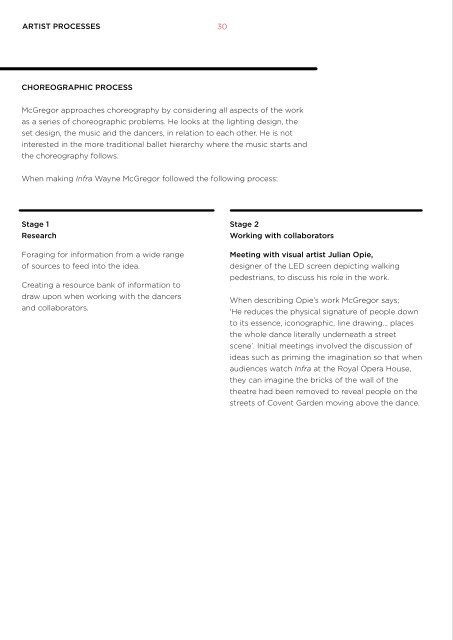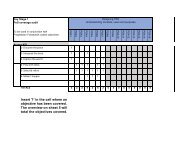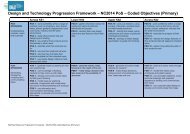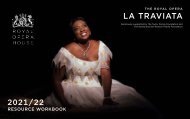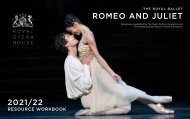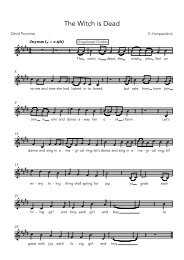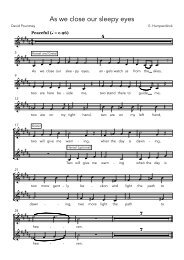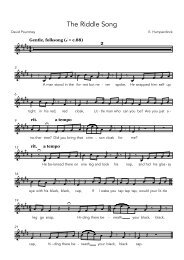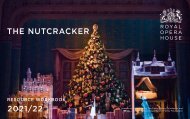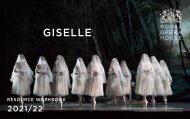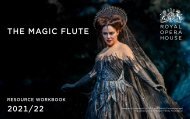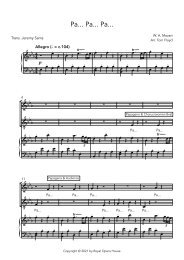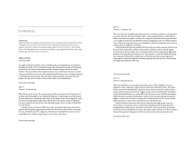Infra GCSE Resource
You also want an ePaper? Increase the reach of your titles
YUMPU automatically turns print PDFs into web optimized ePapers that Google loves.
ARTIST PROCESSES<br />
30<br />
CHOREOGRAPHIC PROCESS<br />
McGregor approaches choreography by considering all aspects of the work<br />
as a series of choreographic problems. He looks at the lighting design, the<br />
set design, the music and the dancers, in relation to each other. He is not<br />
interested in the more traditional ballet hierarchy where the music starts and<br />
the choreography follows.<br />
When making <strong>Infra</strong> Wayne McGregor followed the following process:<br />
Stage 1<br />
Research<br />
Stage 2<br />
Working with collaborators<br />
‘While sitting in my car or standing at a street<br />
corner, I like to watch the natural choreography<br />
of passing pedestrians. Each person is on an<br />
for the CD cover. I in turn intend to ask Max for<br />
a looped clip of music to accompany one of my<br />
hybrid sound and image works. An intertwine<br />
Foraging for information from a wide range<br />
of sources to feed into the idea.<br />
Creating a resource bank of information to<br />
Meeting with visual artist Julian Opie,<br />
designer of the LED screen depicting walking<br />
pedestrians, to discuss his role in the work.<br />
individual trajectory, barely aware of each other<br />
but combining to produce an ever-changing yet<br />
constant dance. By putting people on a walking<br />
treadmill and filming them, I could draw individual<br />
collaboration that was extremely satisfying and<br />
productive for me.<br />
Wayne and I talked and e-mailed extensively over<br />
draw upon when working with the dancers<br />
and collaborators.<br />
When describing Opie’s work McGregor says;<br />
‘He reduces the physical signature of people down<br />
to its essence, iconographic, line drawing… places<br />
the whole dance literally underneath a street<br />
scene’. Initial meetings involved the discussion of<br />
ideas such as priming the imagination so that when<br />
audiences watch <strong>Infra</strong> at the Royal Opera House,<br />
they can imagine the bricks of the wall of the<br />
theatre had been removed to reveal people on the<br />
streets of Covent Garden moving above the dance.<br />
frames and combine these to create a single stride<br />
which, when looped, creates a constantly moving<br />
image, a statue of an individual in motion.<br />
When Wayne asked me to come up with a stage<br />
set I sat in the Royal Opera House and tried to<br />
envisage the entirety, dancers, audience, building.<br />
I imagined the rows of seating continuing onto the<br />
stage - the people pushing to get to their seats –<br />
continuing above the dancers.<br />
The conversation began with a pretty blank canvas.<br />
I did not want to make a scene within which the<br />
the course of a year.<br />
I had shown him drawings and sketches of many<br />
ideas. He lent me dancers and helped choreograph<br />
photo shoots. Wayne is a master of collaboration<br />
but it was new for me. Solutions didn’t arise in a<br />
linear, planned way – we moved back and forth,<br />
side to side – we worked on parallel projects, ideas<br />
were bounced around. Snap decisions were made<br />
and other areas left vague. After much discussion<br />
this refined down to a single line of walkers<br />
crossing the stage above the heads of the dancers.<br />
dancers acted out a story but rather I wanted to<br />
Working with so many people there is an element<br />
create a picture that included the dancers within<br />
of flow, a flow that makes its own currents. I could<br />
the composition. I thought my figures could<br />
not work like that all the time but it was a good<br />
combine with Wayne’s dancers to create a moving,<br />
project. The surprise was how productive it was,<br />
crisscrossing, combining dynamic picture.<br />
even before the curtain went up – or the screen in<br />
our case. I learnt a lot – saw new possibilities in my<br />
While Wayne used my walking figures on his<br />
own work, made some 15 related paintings. I never<br />
stage set I drew his dancers, both in the studio<br />
wanted to make a background to slide behind the<br />
and in rehearsal rooms at the ROH. I made many<br />
dancers, and through a process that I don’t fully<br />
paintings and statues from these sessions allowing<br />
understand I feel Wayne drew from me a much<br />
the amazing dexterity of the dancers to push my<br />
more full collaboration – it was an honour to work<br />
drawings to extremes and allowing the possible<br />
with such a dynamic and inventive yet relaxed and<br />
forms of their bodies to fill canvas and stone and<br />
straightforward artist.’<br />
wood in shapes I would never have imagined<br />
possible. Max Richter came up with a beautiful<br />
Julian Opie<br />
sound track for the piece and used my images


